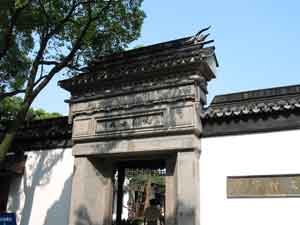|
|||||||||
|
ARTICLESPRIVATE MUSEUMS THREATENED BY DOWNTOWN DEVELOPMENTPrivate museums are playing an increasingly important role in China's cultural heritage "sector" (xitong), bringing valuable collections from the private into the public domain. Some collectibles in private museums document the more intimate aspects of cultural life – the trappings of what was once termed the "lesser way" (xiaodao) of social endeavour – long neglected by state museums. Today they also serve as showcases for collections of antiques acquired at auction by China's nouveaux riches. Outside the ongoing commercial census it is not known how many private museums there are in China, but Xinhua variously reported that by the early 1990s, China had about 80 private museums, and by 1996 the figure had increased to 200.  Fig. 1 View of entrance of Liu Dalin's Chinese Sex Culture Museum in its new home in Tongli, Jiangsu province [BGD] In 2004 several private museums were forced from downtown Shanghai because of skyrocketing rents and a lack of subsidies. Shanghai is the home of China's first private museum to be established in the post-Mao era - The Abacus Museum founded by Chen Baoding in March 1981. Known in Chinese as Suanpan Bowuguan, the museum shares its name with another museum in Qixian county, Shanxi province. Shanghai today claims to have more than 60 private museums focusing on various types of antiques and collectibles, but few museum owners can afford to remain in Shanghai's CBD. Annual rents of RMB100, 000 yuan drove China's largest private museum, the Donghua Porcelain Museum (Donghua Taoci Bowuguan), to move from the downtown district of Shanghai to a small workshop on Huangpi Nan Lu, a much less expensive area. The Er Dongqiang Folk Art Museum (Er Dongqiang Minjian Yishu Bowuguan) and the Ancient Sex Culture Museum (now called the Chinese Sex Culture Museum, Zhonghua Xing Wenhua Bowuguan) have also been forced to move from their original premises. The Er Dongqiang Folk Art Museum showcases a collection of more than 20,000 items of "folk art", ranging from timber fittings on long since demolished traditional-style houses and art deco buildings of Old Shanghai to kitchen appliances, bird cages and skiffs that were once everyday objects in the old houses that lined the canals crisscrossing the Yangtze delta region. The museum, originally located near Shanghai's Hongqiao Airport in a large suburban farmhouse purchased by entrepreneur publisher and photographer Er Dongqiang (better known through his Old China Hand photographic albums as Deke Erh), is being demolished to make way for road construction and real estate development. The Suzhou Folk Art Museum has offered its premises as a home for Er Dongqiang's collection, but as any visitor to the latter poorly maintained and curated museum will appreciate, Deke Erh is not jumping at the offer. The Chinese Sex Culture Museum showcases sexologist Liu Dalin's collection of more than 3,700 erotic artefacts from all periods of ancient and early modern Chinese history. Exhibits range from prehistoric and Han dynasty dildos to an arrestingly solid early 20th century leather corset with breast vents collected in Shanghai. The collection is enhanced by Liu Dalin's popular publications on aspects of ancient and pre-modern erotica. Liu Dalin's museum frequently roused the ire of guardians of public morals and was finally forced out of Shanghai altogether – to Tongli, a picturesque town built on canals about 30 minutes drive from Suzhou (see Fig. 1). Tongli was hoping to be listed along with a number of other canal towns in the vicinity of Suzhou as a world heritage site and the town invested roughly RMB1 million yuan on preparing an attractive venue not far from the well preserved Tuisi Garden for Liu Dalin's museum. In an amusing footnote, the Suzhou authorities possibly overplayed their bid by heavy-handed stage managing of visits by UNESCO delegates, sweeping pedlars off the streets but inadvertently creating the impression that the heritage of this and other beautiful nearby ancient towns was not sustainable. Chengdu, capital of Sichuan province, has, however, proved to be a less commercially hostile environment for private museums. China Daily reported in February 2004 that a local real estate developer and private collector, Fan Jiachuan, has commissioned 20 noted architects to help design a cluster of private museums covering 33 hectares in Anren town, Dayi county, that will document modern Chinese history and house Mr Fan's collections. This fascinating project, including what China Daily incorrectly describes as "China's first museum dedicated to the Cultural Revolution", will prove undoubtedly popular. According to Chinese press reports, Mr Fan has a collection of more than 200,000 items of Maoist memorabilia, including 100 works of "leftist" sculpture, 30,000 badges and 1,000 porcelain busts of Chairman Mao, as well as photographs, posters, stamps, chinaware, letters, uniforms, badges and other antiques from the Mao era. A canteen decorated in the style of the period will bring back the memories of workers, farmers and soldiers eating communally and "ridding themselves of bourgeois liberalism", the paper reported. Another hall will house his collection of more than 10,000 paintings, manuscripts and other antiques from periods of warfare in China's pre-1949 modern history. One of the museums will feature more than 100 pieces of classical furniture. Fan's collection of more than 300 "pen holders" (bitong), made of porcelain, bamboo, marble, jade, ivory and cloisonné, will also be exhibited. Fan has spent RMB 30 million yuan (US$3.6 million) over the past 20 years collecting antiques. Fan, 47, was deputy mayor of his hometown Yibin, Sichuan province, for two years before resigning in 1993 to take up a junior position in a real estate company in Chengdu. Clearly this was a fortuitous financial move, and the public can now enjoy some of the spoils of Fan's entrepreneurial drive and cultural revivalism. Private museums can, of course, often be follies, display unlikely collectibles, or simply parade a director's inflated sense of grandeur, but in China the private museum often provides relief from received notions of orthodoxy that imbue curatorial work in state museums.[BGD] |